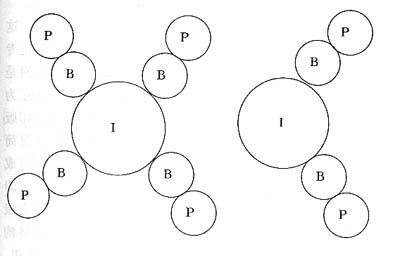2.1 type and roller arrangement of printing machine
2.1.1 Several Typical Printing Machines
1. Satellite-type printing presses.
The characteristics of a full-satellite press are that there is only one impression cylinder, and there are four plate cylinders and a blanket cylinder, as shown in Figure 2.1a:

(Figure 2.1a)
One revolution of the impression cylinder will complete the four-color printing, which is fast and convenient, and it occupies a small space. However, the main disadvantages are: when printing large format, the impression cylinder needs to be large, and the printing plate cylinder and the rubber cylinder are arranged closely, which brings great difficulties for loading and unloading printing plates and rubber; The distance between the two is too short, and the ink is completely wet and wet, which is disadvantageous for the transfer of the ink. Due to these shortcomings, large format multicolor printers have not adopted this type of roller arrangement. 
The semi-satellite printing press features one impression cylinder and two plate rollers and two blanket rollers. As shown in FIG. The two-color printing can be completed by one revolution of the platen roller. Due to the small number of color groups, which can make full use of space for arrangement, and occupy a small space, this type of machine was once accepted by many printing machine manufacturers in the world. Representatively, it is made by the Beijing People’s Machine Factory and Germany Roland Printing Machinery. Factory production of two-color machine. The disadvantage of this model is that the distance between the two colors is too short and the ink is in a wet state. When printing in four colors, the interval between the second color and the third color is too long. Therefore, multi-color printing presses have not adopted such a drum arrangement structure.
2. For roll printing presses.
Roll-type printing press, also known as B-B type printing machine, as shown in Figure 2.1b. This type of printing press does not have a dedicated embossing cylinder, but instead uses an up-and-down blanket for the impression cylinder. That is, the printing ink sets constituted by the upper plate cylinder and the upper blanket cylinder; the lower plate cylinder and the lower blanket cylinder and the upper blanket cylinder constitute another printing color group. The double-sided printing can be completed once, so this model is very suitable for the printing of books and magazines. The disadvantage is that the position is too high, which brings great inconvenience to operation and adjustment. Now, other roller arrangement structures are also used to replace this type of machine.

(Figure 2.1b)
3. Unit printing.
The simplest type of printing machine is composed of a printing color group. This type of printing machine is suitable for printing in a single color. If multi-color printing is required, it must be overprinted. This time-consuming and labor-intensive color printing, and the level of master offset printing is also very high, so there have been multi-color printing presses. At present, almost all multi-color printing presses adopt a unit type drum arrangement structure. The characteristics of the unit structure are: 1 easy to operate. Because from a crew point of view, the arrangement is the simplest and the space available is the most. 2 Because the distance between each unit is much longer than that of satellites, this creates good conditions for the transfer of ink. 3 The group-type printing press is short and has a low center of gravity, which is conducive to the stable operation of the machine. 4 According to the requirements, the number of units can be changed, so the units can be serialized, with strong interchangeability, and also provide convenient conditions for the follow-up of other auxiliary printing equipment (such as optical devices, etc.). Therefore, the group-type printing press has become the main direction for the development of the printing press.

(Figure 2.1c Two-unit printer)
2.1.2 Arrangement of Rollers
The arrangement of the rollers is the most critical part of the offset press design, and it is also one of the most studied places. At present, almost all printers in the market have different angles of arrangement. Which one is more reasonable? At present, there are still no conclusions, because there are many factors that affect the arrangement of rollers. However, regardless of the number of influencing factors, the requirement for its working status is always the same, that is, when the drum is running, the force received is the smallest, and it can always be stabilized in a working state. 2The clutch of the drum is accurate, stable and minimal impact. 3 It is easy to perform various operations on the roller.
From the perspective of the arrangement of the drum, the drum takes up a minimum space in a vertical plane, and the force of the drum is better, but from the viewpoint of clutch pressure, the arrangement angle of the drum is less than 90° (preferably less than 180°) The angle of the roller is called the arrangement angle of the roller, but the force on the roller shaft is the worst. Therefore, the arrangement angle of the roller is generally between 90° and 180°. At present, this angle is about 130°. As shown in Figure 2.2, there are two typical drum arrangements: one with the blanket cylinder on the left and one with the blanket cylinder on the right, each with its own advantages and disadvantages.
Dry Food Bag,Aseptic Bag,Plastic Food Bags,Ziplock Bags
Paper Shopping Bag,Paper Laminated With Plastic Film Co., Ltd. , http://www.chpackingbag.com